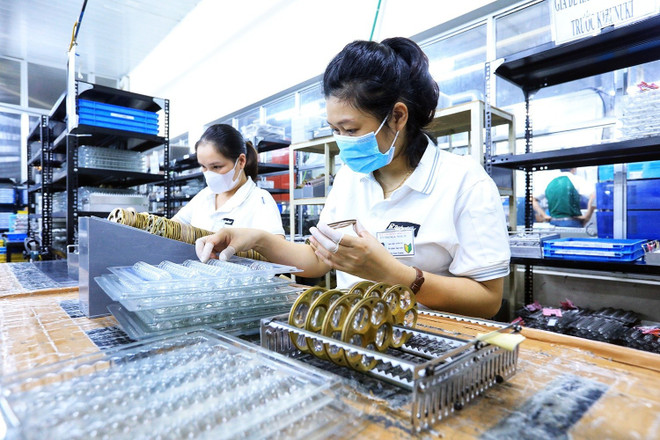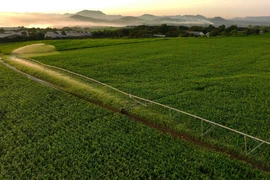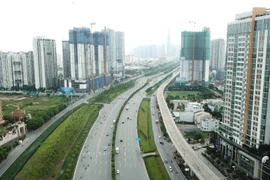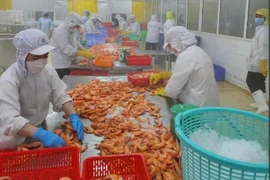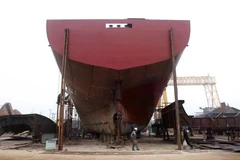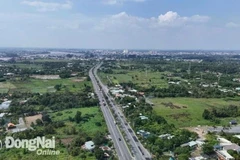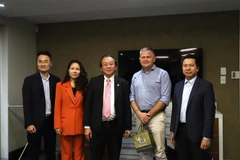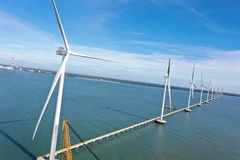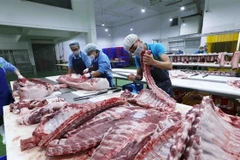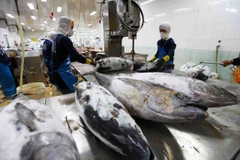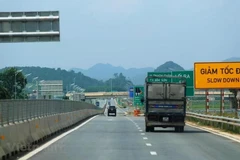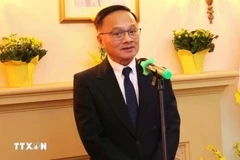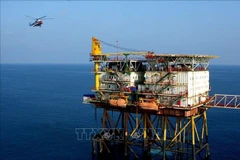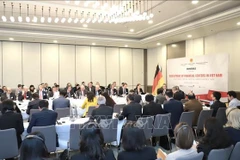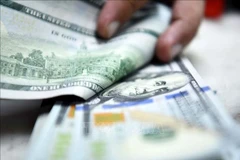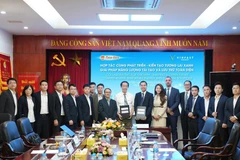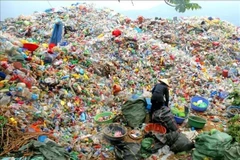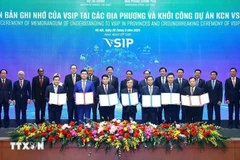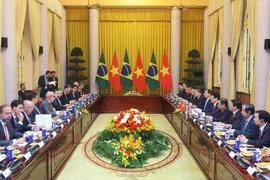Hanoi (VNA) – 2025 is expected to be a breakthrough year for Vietnam’s economy. However, the volatile global context and internal challenges demand greater efforts and determination.
Nguyen Thi Huong, Director General of the National Statistics Office (NSO) under the Ministry of Finance, shared her insights into the Vietnamese economic landscape so far this year, and sketched out solutions to boost the country’s growth in an interview granted to VietnamPlus.
Many positive signs
Reporter: Could you share some of the highlights of Vietnam's economy during the first two months of this year?
Ms. Nguyen Thi Huong: After the Lunar New Year holiday, the economy quickly stabilised and showed positive signs. Specifically, the agriculture sector developed steadily, with the pace of seeding the winter-spring rice crop faster compared to the previous year, and effective livestock production thanks to good consumption markets. In the seafood sector, particularly for tra fish, impressive growth was recorded thanks to high selling prices.
By February 20, the entire country had sown nearly 2.76 million hectares of winter-spring rice, up 4.2% compared to the same period in 2024. Additionally, the farmed aquatic production was estimated at 362,500 tonnes, up 4.6% year-on-year. Notably, industrial production in the first two months grew strongly, achieving the highest level in the same period in the past five years, with the Industrial Index of Production (IIP) increasing by 7.2%. The manufacturing and processing industry continued to be the main driving force with a growth of 9.3%.

In the two-month period, total retail sales and consumer service revenue rose by 9.4% compared to the same period last year. This showed that domestic purchasing power was recovering well. Tourism also showed positive signs, with the number of international visitors increasing significantly, reaching more than 3.96 million, up 30.2% year-on-year.
Regarding international trade, the total import-export value in the first two months reached 127.07 billion USD, up 12% year-on-year. Exports increased by 8.4%, while imports rose by 15.9%, resulting a surplus of 1.47 billion USD.
Notably, public investment was accelerated from the start of 2025, with strong disbursement of state capital, estimated at 73.2 trillion VND, up 21.7% compared to the same period last year. This contributed significantly to economic growth. The positive results from production and business activities also helped state budget revenue to surge 25.7% year-on-year to 499.8 trillion VND.
This outcome was attributed to the decisive leadership of the Government, ministries, sectors, and localities in implementing resolutions and directives on socio-economic development. In addition, the efforts of the business community and the people also played an important role in the recovery and development of the economy. We have proactively seized opportunities from free trade agreements (FTAs), promoting trade and diversifying markets.
Labour market yet to fully recover
Reporter: Alongside these positive developments, the economy has faced some challenges. Could you share more details on them?
Ms. Nguyen Thi Huong: That’s right. Despite the achievements, we have still encountered some issues that need attention. One of these is the labour shortage in some newly established enterprises. In the first two months of the year, the total number of workers registered by newly established enterprises was nearly 140,700, a decrease of 22.7% compared to the same period last year, indicating that the labour market has not fully recovered yet. The import-export growth rate improved, but failed to meet expectations. Additionally, the number of businesses dissolving remained high, reflecting the weak "health" of some enterprises.
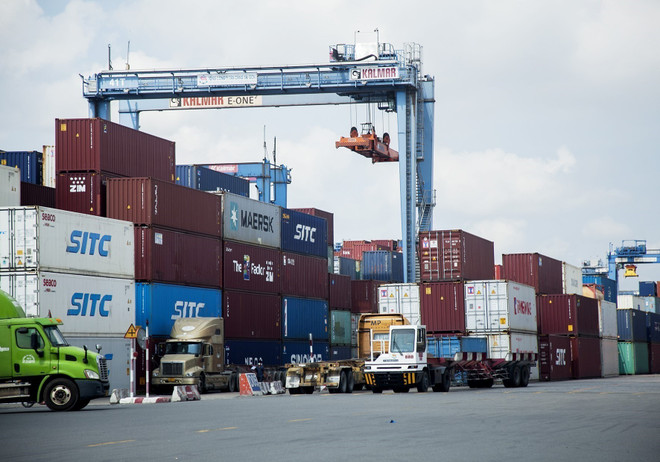
Regarding agriculture, the area sown with some annual crops decreased due to low economic efficiency and limited consumption. Furthermore, deforestation and forest fires continued, causing significant damage to resources and the environment.
Reporter: The growth target for 2025 is over 8%, a challenging figure. In your opinion, what factors could impact this target in the first quarter and throughout the year?
Ms. Nguyen Thi Huong: To achieve this growth target, we need to overcome some of these challenges, especially the decline in the mining sector, particularly in oil and gas production, which could affect overall economic growth. Furthermore, the manufacturing and processing sector needs to achieve a higher growth rate than it currently has. The electricity sector grew only 2.3% in the first two months, much lower than the 13.7% increase in the same period last year. The growth target for the electricity sector in the first quarter is 10.9%, so its IIP must increase by double digits to ensure the set goal is met.
Another point is the low growth in disbursed foreign direct investment (FDI), which accounts for only about 16-20% of total social investment. This poses a significant challenge to achieving the growth target for the whole year. Another notable factor is that domestic purchasing power has not yet reached pre-COVID levels, requiring measures to stimulate consumption.
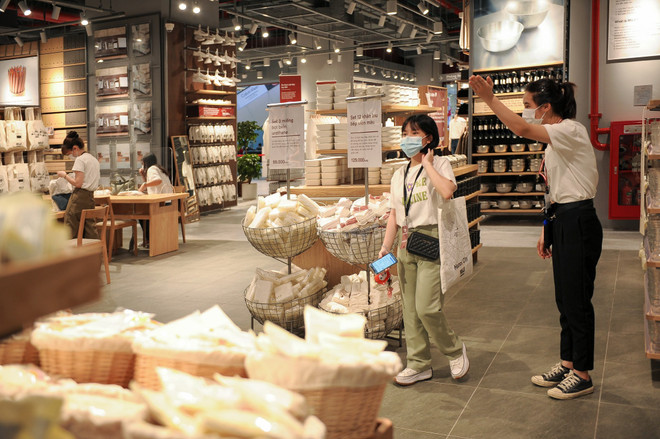
To achieve the target of a 12% increase in total export turnover in 2025, we need to strive for 14% according to the Government’s Resolution 01/NQ-CP issued on January 1, while in the first two months of 2025, exports grew by 8.4% compared to the same period in 2024. This will be a major challenge by the end of 2025, especially given the ongoing global economic fluctuations.
Six urgent solutions
Reporter: According to you, what are the necessary solutions to overcome these challenges and achieve the growth target?
Ms. Nguyen Thi Huong: To generate momentum for growth in the coming months and successfully achieve the 2025 targets, the National Statistics Office proposes several solutions.
First, there must be close, synchronised, and effective coordination among policies. Monetary policy management should be proactive, flexible, timely, and effective. Meanwhile, fiscal policy needs to undergo reasonable expansion, with a focus on supporting production and business and stimulating growth drivers. Relevant agencies should frequently update growth and inflation forecasts to react to policy changes in a timely manner and maintain economic stability. Monitoring global price trends and international and regional situations is essential, along with proactively analysing, forecasting, and issuing timely warnings about potential price risks in the domestic market.
Second, industrial restructuring should be accelerated towards modernisation, focusing on improving productivity and the quality of products in advantageous industries. Additionally, we should proactively develop emerging industries such as chips, semiconductors, and artificial intelligence, while effectively implementing the semiconductor industry development strategy and fostering the support industry. Ensuring the labour supply to meet business production needs is vital. Solutions for building and developing housing for workers, especially in industrial parks and economic zones, should be implemented soon, along with effective training and retraining programmes to enhance workers’ skills and expertise.
Third, boosting exports is a key economic driver. This requires intensifying trade promotion, expanding and diversifying supply chains, production chains, and markets while focusing on improving product quality. Enterprises need to engage more deeply in regional and global supply chains and fully capitalise on opportunities from 17 FTAs already signed.
We need to boost exports to major markets and increase our penetration into new, potential markets like the Middle East, Halal product-consuming countries, Latin America, and Africa.
Additionally, promoting digital transformation in trade promotion and supply-demand connection is crucial, along with continuously updating foreign market information, especially regulations, standards, and conditions that could impact Vietnam's import-export activities.
Fourth, speeding up public investment disbursement and attracting investment are essential. There should be stronger and more timely measures to accelerate public investment disbursement right from early 2025, particularly for important national projects, and national target programmes. Localities should offer attractive policies and create favourable conditions for business, ensuring the attraction of large-scale projects, high-tech industries, and strategic investors to establish research and development centres in Vietnam.
Fifth, proactive measures should be taken to prevent diseases, deal with natural disasters, and protect the environment, including preparing disaster response plans, delivering flood and landslide warnings, and managing drought and saltwater intrusion. These tasks are crucial for protecting production and citizens' livelihoods. Authorities must also increase awareness and legal education on forest protection to minimise damage to production.
Sixth, it is necessary for effective implementation of social welfare policies, labour, employment, and emergency assistance. These measures ensure timely support for people facing risks and disasters, helping them overcome difficulties and stabilise their lives.
Reporter: Thank you for your insights./.
